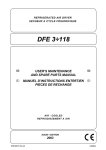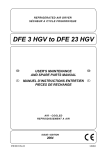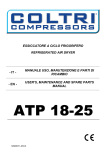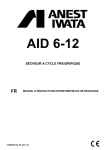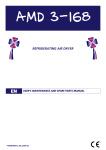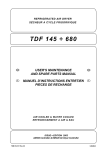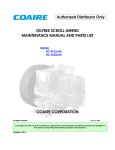Download Coaire CNCM10 Specifications
Transcript
Non-Cycling Refrigerate Air Dryers Installation & Operation Maintenance Manual Models CNCM10 CNCM18 CNCMIOM 01-02 Rev. REL. Model Number: Serial Number: FILL IN COMPLETELY AT INSTALLATION Coaire Technologies Corporation 12226 Coast Drive, Whittier, CA 90601 ◊ TEL.(562)463-3935 ◊ (562)463-4928 website: www.coaire.com ■ e-mail: [email protected]/[email protected] Printed in U.S.A. FORM CM-AD03 FEB. 2002 STATEMENT OF WARRANTY TERMS & CONDITIONS COAIRE’s refrigerated air dryers are warranted to be free of defects in materials and workmanship under proper use, installation, and application. This warranty shall be for a period of 15 months from date of shipment from our factory or other stocking facilities or 12 months from date of installation. Proof of installation date will be required. All dryers outside the U.S. and Canada carry a parts only warranty. ALL FREIGHT DAMAGE CLAIMS ARE NOT THE RESPONSIBILITY OF THE MANUFACTURER AND ARE NOT COVERED UNDER WARRANTY AS ALL PRODUCTS ARE SHIPPED F.O.B. SHIPPER. PLEASE DIRECT ALL FREIGHT CLAIMS TO THE SHIPPER IN QUESTION. MAINTENANCE AND ADJUSTMENTS ADJUSTMENTS TO THE HOT GAS AND MAINTENANCE OF FLOAT AND AUTOMATIC DRAINS AND CONDENSER COILS ARE CONSIDERED TO BE ROUTINE MAINTENANCE AND THEREFORE NONWARRANTABLE ITEMS AND ARE THE SOLE RESPONSIBILITY OF THE END USER. CONSULT THE INSTALLATION, OPERATION AND MAINTENANCE MANUAL FOR THE ADJUSTMENT AND MAINTENANCE PROCEDURES. This warranty does not apply to any unit damaged by accident, modification, misuse, negligence, or misapplication. Damage to heat exchangers by exposure to ammonia, any other corrosive substance or sub-freezing environment will be considered misuse. Any refrigerated dryer part or material found defective will be repaired, replaced or refunded, at the sellers option free of charge, provided that COAIRE is notified within the above stated warranty period. All returns of allegedly defective equipment must have prior written authorization. Said authorization may be obtained through our refrigerated dryer service department. All refrigerated dryers, parts, materials must be returned freight prepaid to the Manufacturer’s factory within 30 days of return authorization date. Any shipment returned to the factory collect will be refused. If an item is found to be warrantable, the repaired item or replacement will be returned normal ground freight prepaid within the continental United States and Canada. Expedited shipment costs are the responsibility of the requestor. Any replacement part or material is warranted only to the extent of the remaining warranty period of the dryer or to the extent as provided by the supplier, whichever is longer. Identification Plate The identification plate is located on the back of the dryer and shows all the primary data of the machine. Upon installation, fill in the table on the previous page with all the data shown on the identification plate. This data should always be referred to when calling the manufacturer or distributor. The removal or alteration of the identification plate will void the warranty rights. DISCLAIMER The warranty does not cover any responsibility or liability for direct or indirect damages to persons, or equipment caused by improper usage or maintenance, and is limited to manufacturing defects only. Refer to COAIRE Warranty policy manual for travel, mileage and special charge considerations. The warranty will be immediately voided if there are changes or alterations to the dryer. WHO TO CONTACT IF YOU HAVE A WARRANTY CLAIM: COAIRE Technologies, Corporation Phone (562) 463-3935 Fax (562) 463-4928 All freight damage claims should be filed within 15 working days and should be directed to the carrier. TABLE OF CONTENTS 1. 2. 3. 4. 5. 6. 7. 8. SAFETY RULES 1.1 Explanation of Convention Symbols Used in This Manual 1.2 Warnings 1.3 Proper Use of the Dryer INSTALLATION 2.1 Transporting the Unit 2.2 Installation site 2.3 Installation layout 2.4 Connection to the Compressed Air System 2.5 Connection to the Main Power 2.6 Condensate Drain START UP 3.1 Preliminary Operations 3.2 Initial Start Up 3.3 Operation and Shut-down TECHNICAL SPECIFICATIONS 4.1 Technical Specifications -CNCM10 & CNCM18 (115/1/60) 4.2 Technical Specifications- CNCM10 & CNCM18 (230/1/60) TECHNICAL DESCRIPTION 5.1 Operation 5.2 Flow diagram 5.3 Refrigeration Compressor 5.4 Condenser 5.5 Filter Drier 5.6 Capillary Tube 5.7 Evaporator 5.8 Hot Gas By-pass Solenoid Valve 5.9 Air-to-Air Exchanger 5.10 Condensate separator 5.11 DMC5 Air Dryer Controller 5.12 Electric Schematic -CNCM10 & CNCM18 MAINTENANCE AND SPARE PARTS 6.1 Maintenance Schedule 6.2 Replacement Parts TROUBLESHOOTING 7.1 Troubleshooting EXPLODED VIEW OF THE DRYER COMPONENTS 8.1 Table of components - Exploded view -CNCM1 & CNCM18 2 1.1 DEFINITION OF THE SAFETY SYMBOLS Carefully read instruction manual before attempting any service or maintenance procedures on the dryer. Caution warning sign. Risk of danger or possibility of damage to equipment, if related text is not followed properly. Electrical hazard. Warning message indicates practices or procedures that could result in personal injury or fatality if not followed correctly. Danger hazard. Part or system under pressure. Danger hazard. High temperature conditions exist during operation of system. Avoid contact until system or component has dissipated heat. Danger hazard. Treated air is not suitable for breathing purposes, serious injury or fatality may result if precautions are not followed. Danger hazard: In case of fire, use an approved fire extinguisher, Water is not an acceptable means in cases of electrical fire Danger hazard. Do not operate equipment with panels removed. Maintenance or control operation to be performed by qualified personnel only 1. ARIA AIR LUFT AIR Compressed air inlet connection point. ARIA AIR LUFT AIR Compressed air outlet connection point. Condensate drain connection point. Operations that can be performed by the operator of the machine, if qualified 1. NOTE : Text that specifies items of note to be taken into account, does not involve safety precautions. In designing this unit a lot of care has been devoted to environmental protection: • CFC free refrigerants • CFC free insulation parts • Energy saving design • Limited acoustic emission • Dryer and relevant packaging composed of recyclable materials This symbol requests that the user heed environmental considerations and abide with suggestions annotated with this symbol. 1 Experienced and trained personnel familiar with national and local codes, capable to perform the needed activities, identify and avoid possible dangerous situations while handling, installing, using and servicing the machine. Ensuring compliance to all statutory regulations 3 1.2 WARNINGS Compressed air is a highly hazardous energy source. Never work on the dryer with pressure in the system. Never point the compressed air or the condensate drain outlet hoses towards anybody. The user is responsible for the proper installation of the dryer. Failure to follow instructions given in the “Installation” chapter will void the warranty. Improper installation can create dangerous situations for personnel and/or damages to the machine could occur. Only qualified personnel are authorized to service electrically powered devices. Before attempting maintenance, the following conditions must be satisfied : Ensure that main power is off, machine is locked out, tagged for service and power cannot be restored during service operations. Ensure that valves are shut and the air circuit is at atmospheric pressure. De-pressurize the dryer. Warranty does not apply to any unit damaged by accident, modification, misuse, negligence or misapplication. Unauthorized alterations will immediately void the warranty. In case of fire, use an approved fire extinguisher, Water is not an acceptable means in cases of electrical fire. 1.3 PROPER USE OF THE DRYER This dryer has been designed, manufactured and tested for the purpose of separating the humidity normally contained in compressed air. Any other use has to be considered improper. The Manufacturer will not be responsible for any problem arising from improper use; the user will responsible for any resulting damage. Moreover, the correct use requires the adherence to the installation instructions, specifically: • Voltage and frequency of the main power. • Pressure, temperature and flow-rate of the inlet air. • Ambient temperature. This dryer is supplied tested and fully assembled. The only operation left to the user is the piping connections to the compressed air system in compliance with the instructions given in the following chapters. The purpose of the machine is the removal of water and residual oil vapor present in compressed air. The dried air cannot be used for respiration purposes or for operations leading to direct contact with food products. This dryer is nor suitable for the treatment of dirty air or of air containing solid particles. 2.1 TRANSPORTING THE UNIT Check for visible loss or damage, if no visible damage is found place the unit near to the installation point and unpack the contents. • Always keep the dryer in the upright vertical position. Damage to components could result if unit is laid on it’s side or if placed upside down. • Store machine in a clean, dry environment, do not expose to severe weather environments. The packaging materials are recyclable. Dispose of material in compliance with the rules and regulations in force in the destination country. 4 2.2 INSTALLATION SITE Failure to install dryer in the proper ambient conditions will affect the dryer’s ability to condense refrigerant gas. This can cause higher loads on the compressor, loss of dryer efficiency and performance, overheated condenser fan motors, electrical component failure and dryer failure due to the following: compressor loss, fan motor failure and electrical component failure. Failures of this type will affect warranty considerations. Do not install dryer in an environment of corrosive chemicals, explosive gasses, poisonous gasses, steam heat, areas of high ambient conditions or extreme dust and dirt. In case of fire, use an approved fire extinguisher, Water is not an acceptable means in cases of electrical fire. Minimal installation requirements: • Select a clean dry room, free from dust, and protected from atmospheric disturbances. • The supporting plate must be smooth, horizontal and able to hold the weight of the dryer. • Minimum ambient temperatures 34°F see the data plate for maximum temperature. • Allow at least 16 inches of clearance on each side of the dryer for proper ventilation and to facilitate maintenance operations. The dryer doesn't require to be fixed to the supporting surface. Locks will be required for special installations (on brackets, hanging, etc.). 2.3 INSTALLATION LAYOUT IN 5 3 OUT 6 4 8 1 9 2 9 9 9 7 1 Air compressor 6 Final filter 2 Aftercooler 7 Dryer 3 Condensate separator 8 By-pass group (optional) 4 Pre-Filter 9 Condensate drain 5 Compressed air receiver Correction factor for inlet air pressure changes: Inlet air pressure psig 60 70 Factor 0.70 0.85 85 0.93 Correction factor for ambient temperature changes: Ambient temperature ºF 80 Factor 1.09 100 1.00 90 1.06 Correction factor for inlet air temperature changes: Air temperature ºF 90 Factor 1.15 Correction factor for DewPoint changes: DewPoint ºF 38 Factor 1.00 115 1.06 130 1.11 100 1.00 100 1.00 40 1.05 5 140 1.15 155 1.18 110 0.90 110 0.82 44 1.10 170 1.21 200 1.25 115 0.83 115 0.75 47 1.15 50 1.20 232 1.28 2.4 CONNECTION TO THE COMPRESSED AIR SYSTEM Operations to be performed by qualified personnel only. Never work on compressed air piping under pressure. The user is responsible to ensure that the dryer will never be operated with pressure exceeding the maximum pressure rating on the unit data tag. Over pressurizing the dryer could be dangerous for both the operator and the machine. The air temperature and the scfm entering the dryer must comply with the limits reported on the data nameplate. The system connecting piping must be kept free from dust, rust, chips and other impurities, and must be consistent with the flow-rate of the dryer. In order to perform maintenance operations, it recommended that by-pass piping be installed, as shown in illustration 1.1. DRYER INLET DRYER OUTLET FROM COMPRESSOR TO POINT OF USE Illustration 1.1 Particular measures have been taken to reduce the amount of vibration that could occur during the operation. Therefore, we recommend the use of connecting pipes that are able to insulate the vibration. (Flexible hoses, vibration damping fittings, etc.) 2.5 Electrical Connections Qualified personnel should carry out connections to the main power. Be sure to check the local codes in your area. Before connecting the unit to the electrical supply, verify the data nameplate for the proper electrical information. Voltage tolerance is +/- 5%. 115/1/60 dryers are supplied with a standard North American power cord and plug assembly (two poles and a ground. 230/1/60 dryers are supplied with a standard North American power cord and plug assembly (two poles and a ground. Be sure to provide the proper fuses or breakers based on the data tag information located on the back of the unit. The main power receptacle must be protected with a thermal overload relay (I∆n+0.03A), rated to the power consumption of the dryer (refer to data nameplate for nominal values). The power supply cord must meet or exceed ratings for the total amp draw of the unit. Connect to a properly grounded outlet. Improper connection of the equipment-grounding conductor can result in risk of electric shock. Do not use adapters on the plug receptacle- if it will fit the outlet, have a proper outlet installed by a qualified electrician. 2.6 CONDENSATE DRAIN Discharge is at system pressure. Drain line should be secured. Never point the condensate drain line towards anybody. The dryer comes with a flexible plastic drain tube (1/4”in diameter and 60in long) for the connection to suitable drain. Removal of the condensate occurs through a solenoid valve protected with a mechanical filter. In order to avoid clogging of the solenoid valve, the condensate from the cyclone separator is previously filtered, than discharged. An adjustable electronic timer operates the solenoid valve coil. The drain cannot be connected to pressurized systems. Condensate may contain oil. Comply with applicable laws concerning disposal. A water-oil separator should be installed before the air inlet to the dryer for the purpose of removing condensate drainage coming from compressors, dryers, tanks, filters, etc. 6 3.1 PRELIMINARY OPERATION Verify that the operating parameters match with the nominal values reported on the data nameplate of the dryer (voltage, frequency, air pressure, air temperature, ambient temperature, etc.). This dryer has been thoroughly tested, packaged and inspected prior to shipment. Nevertheless, the unit could be damaged during transportation, check the integrity of the dryer during initial start-up and monitor operation during the first hours of operation. Qualified personnel must perform the initial start-up. When installing and operating this equipment, comply with all National Electrical Code and any applicable federal, state and local codes. 3.2 INITIAL START-UP This procedure should be followed on initial start-up, after periods of extended shutdown or following maintenance procedures. Qualified personnel must perform the start-up. Sequence of operations: • Ensure all steps of the “Installation” chapter have been followed. • Confirm that all piping and electrical connections are proper.. • Ensure condensate drain lines are properly fastened and connected to a suitable drain system. • If a by-pass is installed around the dryer, close the inlet and outlet isolation valves, open the by-pass valve. • Verify that the manual valve mounted on condensate drain circuit is open. • Remove all packaging and other material that could obstruct the area around the dryer. • Turn on the main power to the unit • Move the rocker “ON/OFF” switch to the “ON” position (in the on position the switch should be illuminated). • Compare amp draw to nominal values on the data nameplate. • Verify the operation of the condensate drain circuit - wait for first activation. • Allow the dryer temperature to stabilize at the pre-set value. • Slowly open the air inlet valve. • Slowly open the air outlet valve. • Slowly close the central by-pass valve of the system • Check the piping for air leakage. 3.3 START-UP AND SHUT DOWN Operation : • Check the condenser for cleanliness. • Verify power to the system. • Move the rocker “ON/OFF” switch to the “ON” position. • Turn on the air compressor. Switching off : • Switch off the air compressor. • After few minutes, Move the rocker “ON/OFF” switch of the dryer to the “OFF” position. During the operation, the refrigeration compressor and the condenser unit fan will run continuously. The dryer must remain ON whenever compressed air is being used, even if the air compressor only loads intermittently. 7 4.1 TECHNICAL SPECIFICATIONS CNC18-CNC75 (115/1/60) A I H I B J E INLET Entrée 1 D F OUTLET Sortie 2 C 3 A B C D E F G H I J K L M Inches 14.562 17.625 17.437 2.500 1.375 2.00 2.750 15.562 1.062 2.437 .375 1.00 .562 mm 370 449 443 65 35 51 69 395 27 62 10 26 14 B G A 1-Rocker On/Off Switch-Illuminated 2-Power Supply Cord 3-Condensate Drain DRYER MODEL Air flow rate at nominal condition1 Pressure DewPoint at nominal condition1 Nominal ambient temperature Max. ambient temperature Min. ambient temperature Nominal inlet air temperature Max. inlet air temperature Nominal inlet air pressure Max. inlet air pressure Max. outlet air pressure drop - ∆p Inlet-outlet air connection Refrigerant type Refrigerant charging CNCM10 10 285 17 [scfm] [Nl/min] [Nm3/h] CNCM18 15 425 26 38 – 3.3 [°F - °C] [°F - °C] [°F - °C] [°F - °C] [°F - °C] [°F - °C] [psig – barg] [psig - barg] 100 - 37.8 115 – 45 34 – 1 100 - 37.8 115 – 45 100 - 6.9 232 – 16 4.4 - 0.3 [psi – bar] Copper pipe OD 3/8 in. (9.52 mm) R134.a (HFC) - CH2F-CF3 6.1/8 - 175 12.3/8 - 350 120 - 200 200 - 340 [oz – g] [cfm - m3/h] Cooling air capacity Power supply [Phase/V/Hz] 115/1/60 Nominal electric consumption [A] 2.2 3.0 Max. electric consumption [A] 2.9 4.2 Compressor power [HP] 1/8 1/5 Weight [lbs - kg] 62 - 28 68 - 31 Max. noise level < 70 dbA at 40in (1m) 1 The nominal condition refers to an ambient temperature of 100°F with inlet air at 100 psig and 100°F 8 4.2 TECHNICAL SPECIFICATIONS CNC18-CNC75 (230/1/60) A I H I B J E INLET Entrée 1 D F OUTLET Sortie 2 C 3 A B C D E F G H I J K L M Inches 14.562 17.625 17.437 2.500 1.375 2.00 2.750 15.562 1.062 2.437 .375 1.00 .562 mm 370 449 443 65 35 51 69 395 27 62 10 26 14 B G A 1-Rocker On/Off Switch-Illuminated 2-Power Supply Cord 3-Condensate Drain DRYER MODEL Air flow rate at nominal condition1 Pressure DewPoint at nominal condition1 Nominal ambient temperature Max. ambient temperature Min. ambient temperature Nominal inlet air temperature Max. inlet air temperature Nominal inlet air pressure Max. inlet air pressure Max. outlet air pressure drop - ∆p Inlet-outlet air connection Refrigerant type Refrigerant charging CNCM10 10 285 17 [scfm] [Nl/min] [Nm3/h] CNCM18 15 425 26 38 – 3.3 [°F - °C] [°F - °C] [°F - °C] [°F - °C] [°F - °C] [°F - °C] [psig – barg] [psig - barg] 100 - 37.8 115 – 45 34 – 1 100 - 37.8 115 – 45 100 - 6.9 232 – 16 4.4 - 0.3 [psi – bar] Copper pipe OD 3/8 in. (9.52 mm) R134.a (HFC) - CH2F-CF3 6.1/8 - 175 12.3/8 - 350 120 - 200 200 - 340 [oz – g] [cfm - m3/h] Cooling air capacity Power supply [Phase/V/Hz] 230/1/60 Nominal electric consumption [A] 1.1 1.4 Max. electric consumption [A] 1.5 1.7 Compressor power [HP] 1/8 1/5 Weight [lbs - kg] 62 - 28 68 - 31 Max. noise level < 70 dbA at 40in (1m) 1 The nominal condition refers to an ambient temperature of 100°F with inlet air at 100 psig and 100°F 9 5.1 OPERATION Operating principal-The dryer models described in this manual operate all on the same principal. The hot moisture laden air enters an air to air heat exchanger. The air then goes through the evaporator, also known as the air to refrigerant heat exchanger. The temperature of the air is reduced to approximately 35-39 degrees Fahrenheit, causing water vapor to condense to liquid. The liquid is continuously coalesced and collected in the separator for removal by the condensate drain. The cool moisture free air then passes back through the air to air heat exchanger to be reheated to within fifteen degrees of the incoming air temperature as it exits the dryer. Refrigerant circuit - Refrigerant (R-134a) gas is cycled through the compressor and exits at high pressure to an air condenser where heat is removed causing the refrigerant to condense to a high pressure liquid state. The liquid is forced through a metering device (capillary tube) where the resulting pressure drop allows the refrigerant to boil off at a predetermined temperature. Low pressure liquid refrigerant enters the heat exchanger where heat from the incoming air is transferred causing the refrigerant to boil, the resulting phase change produces a low pressure, low temperature gas. The low pressure gas is returned to the compressor, where it is recompressed and begins the cycle again. During those periods when the compressed air load is reduced the excess refrigerant is bypassed automatically back to the compressor via the hot gas by-pass valve circuit. 5.5 AIR/REFRIGERANT FLOW DIAGRAM CNCM10-CNCM18 7 14 12 ELE 5 8 6 1 13 2 M 11 4 3 10 9 12 ELE 1 Refrigeration compressor 8 Condensate separator 2 Condenser unit 9 Condensate drain valve/strainer 3 Solid filter drier 10 Condensate drain solenoid valve 4 Capillary tube 11 Condenser unit fan 5 Evaporator - Air-to-refrigerant heat exchanger 12 Electronic controller – DMC5 6 Hot gas by-pass solenoid valve 13 DewPoint temperature probe 7 Air-to-air heat exchanger 14 By-pass system (optional) Air flow direction Refrigerant flow direction 10 5.3 REFRIGERATION COMPRESSOR The refrigeration compressor is the pump of the system where the gas coming from the evaporator (low pressure side) is compressed up to the condensation pressure (high pressure side). The compressors utilized are manufactured by primary companies and are designed for applications where high compression ratios and wide temperature changes are present. The fully sealed construction is perfectly gas tight, so ensuring high-energy efficiency and long useful life. Dumping springs supports the pumping unit, in order to consistently reduce the acoustic emission and the vibration diffusion. The electric motor is cooled by the aspirated refrigerating gas, which goes through the coils before reaching the compression cylinders. The thermal protection protects the compressor from over heating and over currents. The protection is automatically restored as soon as the nominal temperature conditions are reached. 5.4 CONDENSER UNIT The condenser is the element in which the gas coming from the compressor is cooled down and condensed becoming a liquid. Mechanically, a copper tubing circuit (with the gas flowing inside) forms it immersed in an aluminum fin package. The cooling operation occurs via a high efficiency fan, which, in applying pressure on the air contained within the dryer, forces it into the fin package. It’s mandatory that the temperature of the ambient air will not exceed the nominal values. It is also important TO KEEP THE UNIT FREE FORM DUST AND OTHER IMPURITIES. 5.5 FILTER DRIER Traces of humidity and slag can accumulate inside the refrigeration circuit, or long periods of use can produce sludge, could limit the lubrication of the compressor and clog the expansion valve or capillary tube. The function of the filter drier, located before the capillary tubing, is to stop the impurities, avoiding their circulation within the system. 5.6 CAPILLARY TUBE It consists of a piece of reduced cross section copper tubing located between the condenser and the evaporator and acts as a metering device to reduce the pressure of the refrigerant. Reduction of pressure is a function of the temperature to be reached within the evaporator: the smaller the capillary tube outlet pressure, the lower the evaporation temperature. The length and interior diameter of the capillary tubing is accurately sized with the performance to be reached by the dryer; no maintenance or adjustment is necessary. 5.7 EVAPORATOR Also called an air-refrigerant exchanger. The liquid refrigerant formed in the condenser is evaporated in this part of the circuit. In the evaporation phase the refrigerant side of the evaporator tends to absorb heat from the compressed air present in the other side of the exchanger. The evaporator is immersed in the cabinet base of the dryer and insulated with non-CFC expanded insulating foam. The part is entirely constructed in copper and the cooler goes in the opposite direction to the air, thus contributing to limited pressure loss and to provide efficient thermal exchange. 5.8 HOT GAS BY-PASS SOLENOID VALVE This valve is located between the pressure side of the compressor and the terminal side of the evaporator. Its purpose is to avoid conditions of low thermal charge in the dryer (low air flow or relatively cold air) The temperature inside the evaporators will drop below 32ºF. Temperature below 32ºF would eventually allow the formation of ice inside the evaporator, with the consequent blockage of air flow and, in the worst of the cases, the rupture of the evaporator itself. The DMC11 Controller activates the coil of the solenoid valve. 5.9 AIR-TO-AIR EXCHANGER The purpose of this exchanger is the transmission of the heat of the incoming air to the exiting cold air. The benefits of this solution are basically twofold: the incoming air is partially cooled down. Therefore the chilling system can be sized for a lower thermal drop, thus allowing a 40-50% energy saving; moreover, cool air will never reach the compressed air circuit and condensate will not form on the external surface of the piping. 11 5.10 CONDENSATE SEPARATOR The cold air exiting the evaporator circulates into the centrifugal type condensate separator. By means of a winged diaphragm, the incoming air attains a high-speed rotary motion. Therefore, due the centrifugal force, the condensed particles are projected onto the lateral surface and then migrate to the bottom, which acts as an accumulation reservoir for the separated condensate and is expelled by the drain solenoid valve at regular intervals. The resulting condensate free air exits the separator and is driven into the air-to-air exchanger. The centrifugal type separator offers the advantage of high efficiency, even with variable flow-rates. It doesn’t require maintenance, it does not clog and it is able to separate solid particles as well. 5.11 DMC5 AIR DRYER CONTROLLER PROBE °C - + F EDCB A ON 1 2 3 4 5 6 Trimmer DIPS The DMC5 Air Dryer Controller controls the operation of the dryer, and allows adjustment to the operating parameters. A temperature-dependent semiconductor probe located at the end of the evaporator controls the hot-gas solenoid valve activation. An electronic timer drives the condensate drain solenoid valve at regular intervals. The DMC5 Air Dryer Controller is preset to factory specifications for typical use. The following parameters can be changed to meet specific user requirements: L N COM B D The parameters which can be set up are the following : SET-POINT SET-UP Set-Point is the activation temperature of the hot-gas by-pass solenoid valve. Factory specification for Set Point is 37.4 to 39.2 °F (3 to 4 °C), with a fix hysteresis - ∆t - equal to 0.9 °F (0.5 ºC). The hot gas by-pass solenoid valve is activated when the temperature falls below 37.4 to 39.2 °F (3 to 4 °C) and deactivated when the temperature rises over 38.3 to 40.1 °F (3.5 to 4.5 °C). To adjust the Set Point perform the following steps: • Put a thermometer in the vacant copper well near the similar copper well that houses the DMC probe (insert the thermometer to the bottom of the copper well). • Remove the air flow and switch ON the dryer and wait a few minutes. • Using a small screw driver rotate the set-point adjusting trimmer so the hot gas solenoid valve coil energizes at a temperature between 37.4 and 39.2 °F (from 3 to 4 °C). By rotating the trimmer clockwise, the set-point will increase up to a top value of approx. 50°F (10°C); by rotating the trimmer counter clockwise, the set-point will decrease down to a minimum value of approx 32°F (0°C). NOTE: TO BE PERFORMED BY AUTHORIZED PERSONNEL ONLY! WARRANTY WILL BE VOIDED IF DONE INCORRECTLY. DRAINING TIME SET-UP There are two adjustable parameters related to drain timing: • • TON - condensate drain solenoid valve activation duration time. TOFF - Interval time between activation of the condensate drain solenoid valve. To modify these two times, simply move the 6 micro-switches (DIPS) following the schedule below: TOFF - pause time DIPS Time [sec] TON - activation time D+E+F D+E D+F E+F F E D C B A 210 180 150 90 30 60 120 1 2 4 DIPS A, B & C adjust activation time (TON). DIPS D, E & F adjust pause time (TOFF); pause time can be cumulated (i.e. DIPS E+F, D+F, D+E and D+E+F). Standard setting: DIP B and E set to ON equal to TON = 2 sec and TOFF = 60 sec. Drain solenoid valve will be activated 2 seconds every 60 seconds. 12 5.21 ELECTRICAL SCHEMATIC CNCM10 & CNCM18 DMC5 PE Air Dryer Controller POPui ssa WE R nce N COM B D PROBE Sonde Vc M PR EVB M EVD Legend: IG : Rocker On/Off switch K : Refrigeration compressor KR : Compressor start-up relay KM : Compressor electric motor KT : Compressor thermal protection VC PR EVB EVD : Condenser fan motor : DMC5 probe : Hot gas by-pass solenoid valve : Condensate drain solenoid valve 6.1 MAINTENANCE SCHEDULE Only qualified personnel should perform maintenance operations. Prior to performing any maintenance or service, be sure that: • Ensure that the power is off and the unit is at atmospheric pressure. • Main power circuit breaker is in the off position per lock out/tag out procedures. • Ensure that maintenance personnel have read and understand the safety and operations instructions in this manual. High temperature conditions exist during operation of system. Avoid contact until system or component has dissipated heat. DAILY • Verify that the DewPoint displayed on the DMC11 is correct. • Check the proper operation of the condensate drain system. • Inspect the condenser for cleanliness. EVERY 200 HOURS OR MONTHLY • Blow entire unit out with compressed air (Max. 30 psig - 2 barg) • Blow condenser coils out with compressed air. • Close the manual condensate drain valve, remove the mechanical filter and clean it with compressed air and a brush. Reinstall the filter, make sure it is tight, and open the manual valve. • Verify operation of the machine. EVERY 1000 HOURS OR YEARLY • Tighten all electrical connections. Look for broken, cracked or bare wires. • Inspect refrigeration circuit for signs of oil and refrigerant leakage. • Measure and record amperage. Verify that readings are within acceptable parameters as listed in specification table. • Inspect condensate drain flexible hoses, and replace if necessary. • Verify operation of the machine. 13 6.2 REPLACEMENT PARTS = Suggested spare part. DESCRIPTION Part Number Refrigeration compressor Refrigeration compressor Refrigeration compressor Refrigeration compressor Fan motor Fan motor Fan motor Fan blade Fan blade Fan grid DMC5 Air Dryer Controller 115V DMC5 Air Dryer Controller 230V DMC5 Probe Lighted main switch Condensate drain valve/strainer Condensate drain solenoid valve – body Condensate drain solenoid valve – coil 115V Condensate drain solenoid valve – coil 230V By-pass solenoid valve - body By-pass solenoid valve – coil 115V By-pass solenoid valve – coil 230V NOTE: 5015135001 5015135005 5015110001 5015110004 5210135005 5210135010 5215000010 5215000005 5215000019 5225000010 5620130105 ? 5625NNN005 5450SZN010 64355MN012 64320FF005 64N22MM035 64N22MM005 64120SS005 64N22MM055 64N22MM060 CNCM10 115/1/60 1 CNCM18 CNCM10 CNCM18 115/1/60 230/1/60 230/1/60 1 1 1 1 1 1 1 1 1 1 1 1 1 1 1 1 1 1 1 1 1 1 1 1 1 1 1 1 1 1 1 1 When ordering a replacement part, have information from data nameplate available. 7.1 TROUBLESHOOTING Only qualified personnel should perform maintenance operations. Prior to performing any maintenance or service, be sure that: • Ensure that the power is off and the unit is at atmospheric pressure. • Main power circuit breaker is in the off position per lock out/tag out procedures. • Ensure that maintenance personnel have read and understand the safety and operations instructions in this manual. • High temperature conditions exist during operation of system. Avoid contact until system or component has dissipated heat. SYMPTOM Î The machine doesn't start. Î The compressor doesn’t work. POSSIBLE CAUSE - SUGGESTED ACTION Î Î Î Î Î Î Î Î Î Î Check inlet power. Verify electric wiring connections. Check continuity of On/Off switch Activation of the internal thermal protection - wait for 30 minutes, then retry. Verify the electric wiring. Replace the internal thermal protection. If present, replace the start-up relay. If present, replace the start-up capacitor. If present, replace the run capacitor. If the compressor doesn’t work yet, replace it. Î The condenser fan doesn’t work. Î Verify the electric wiring. Î If the fan still doesn’t work, replace it. Î DewPoint too high. Î Î Î Î Î The dryer is off - switch it on. The compressor doesn’t work - see specific point. The condenser fan doesn’t work - see specific point. The inlet air is too hot - restore the nominal conditions. The inlet air flow rate is higher than the rate of the dryer - reduce the flow rate - 14 restore the normal conditions. Î The ambient temperature is too high or the room ventilation is insufficient provide proper ventilation. Î The set-point of the DMC5 is too high - see paragraph SET-UP of the DMC5. Î The condenser is dirty - clean it. Î The dryer doesn’t drain the condensate - see specific point. Î There is a leak in the refrigeration circuit - contact a certified refrigeration technician Î DewPoint too low. Î Î Î Î Î Î Î Î Verify wiring of the DMC5. Verify wiring of the DMC5 probe Verify wiring of the hot gas by pass solenoid valve. The electric coil of the hot gas by-pass solenoid valve may have burned out – test resistance/ replace it. The probe of the DMC5 does not properly detect the temperature of the evaporator – push the probe until it reaches the bottom of the measurement well. The set-point of the DMC5 is very low - see paragraph SET-UP of the DMC5. DMC5 Air Dryer Controller doesn’t work - replace it. The hot gas solenoid valve is blocked - contact a certified refrigeration technician. Î Excessive pressure drop within the dryer. Î The DewPoint is too low - the condensate is frozen and blocks air flow - see specific point. Î Check for throttling the flexible connection hoses. Î The condensate is not draining Î Î Î Î Î The dryer continuously drains condensate. Î The drain solenoid valve is jammed - remove and clean it. Î Verify the electric wiring. Î DMC5 doesn’t work - replace it. Î Water within the line. Î Î Î Î Verify the electric wiring. The condensate drain mechanical filter is clogged - remove and clean it. The drain solenoid valve is jammed - remove and clean it. The electrical coil on the condensate drain solenoid valve may be burned out- test resistance/replace it. Î DMC5 doesn’t work - replace it. Î The DewPoint is too low - the condensate is frozen - see specific point. The dryer is off - switch it on. Untreated air flows through the by-pass unit (if installed) - close the by-pass. The dryer doesn’t drain condensate - see specific point. DewPoint too high - see specific point. 15 8.1 TABLE OF COMPONENTS - EXPLODED VIEW –CNCM10 & CNCM18 The components table given below refers to the relevant exploded views attached to this manual. 1 Heat exchanger group 9 Cabinet - Front panel 2 Refrigeration compressor 10 Cabinet - Rear panel 3 Condenser unit 11 Cabinet - Cover panel 4 Condenser unit fan 12 Cabinet - Lateral panel 5 Solid filter dryer 13 Inlet/Outlet connections 6 Hot gas by-pass solenoid valve 14 Rocker switch-Illuminated 7 Condensate drain valve/strainer 15 DMC5 Air Dryer Controller 8 Condensate drain solenoid valve 16 DewPoint copper tube immersion well 7 8 11 1 13 16 12 14 10 9 4 3 6 15 16 5 2 For complete line of additional product information, please contact your local COAIRE distributor. DISTRIBUTED BY COAIRE Technologies reverse the right to make changes, at any time without notice as a result of our commitment to continuous improvement. Coaire Technologies Corporation 12226 Coast Drive, Whittier, CA 90601 ◊ TEL.(562)463-3935 ◊ (562)463-4928 website: www.coaire.com ■ e-mail: [email protected]/[email protected] 17


















